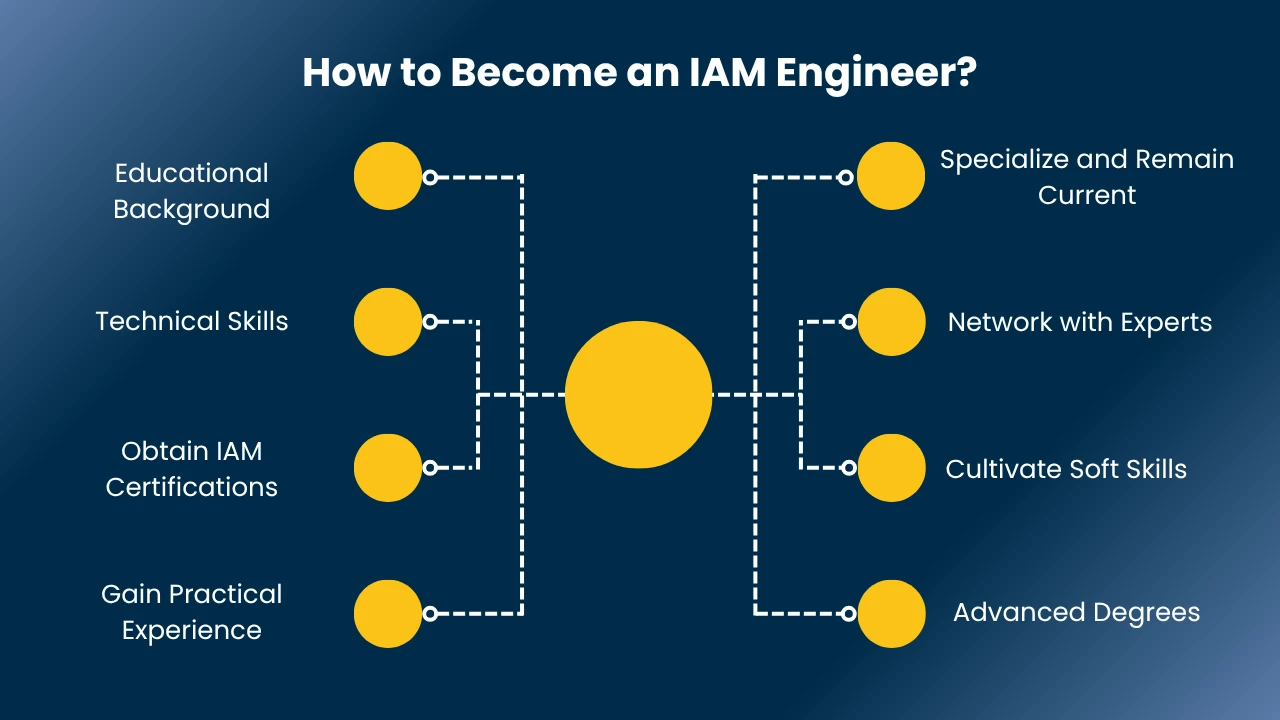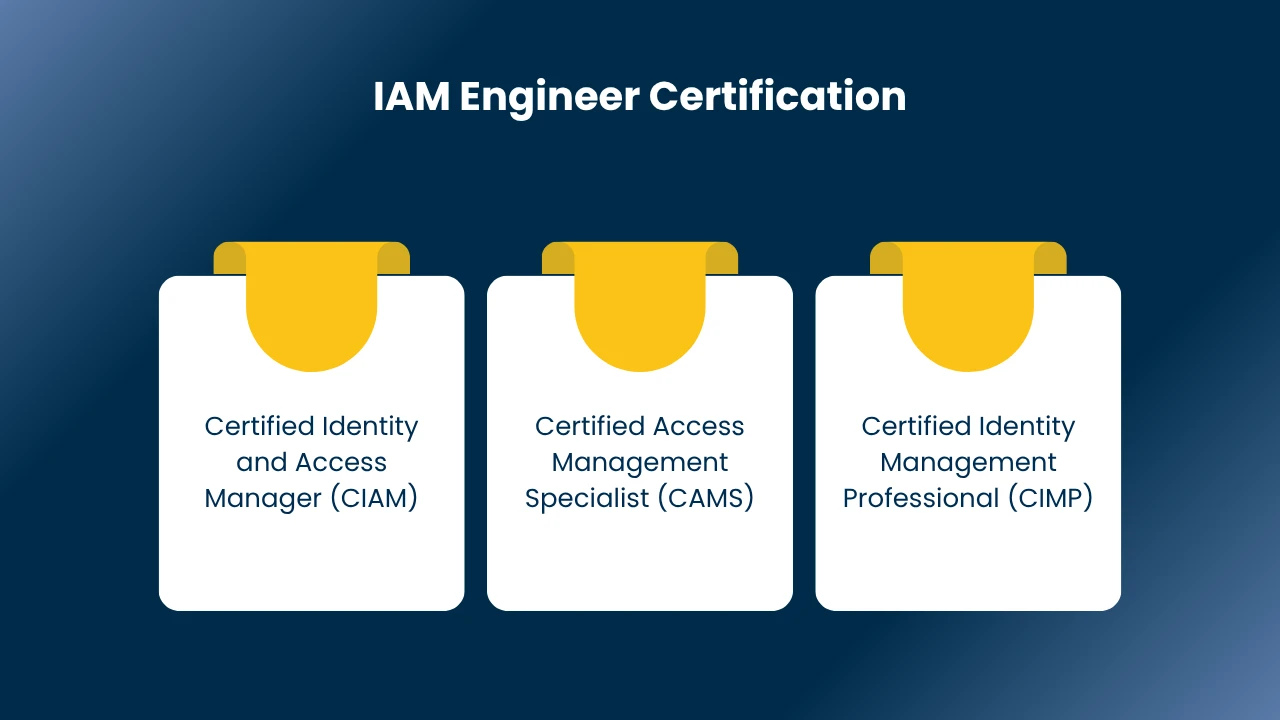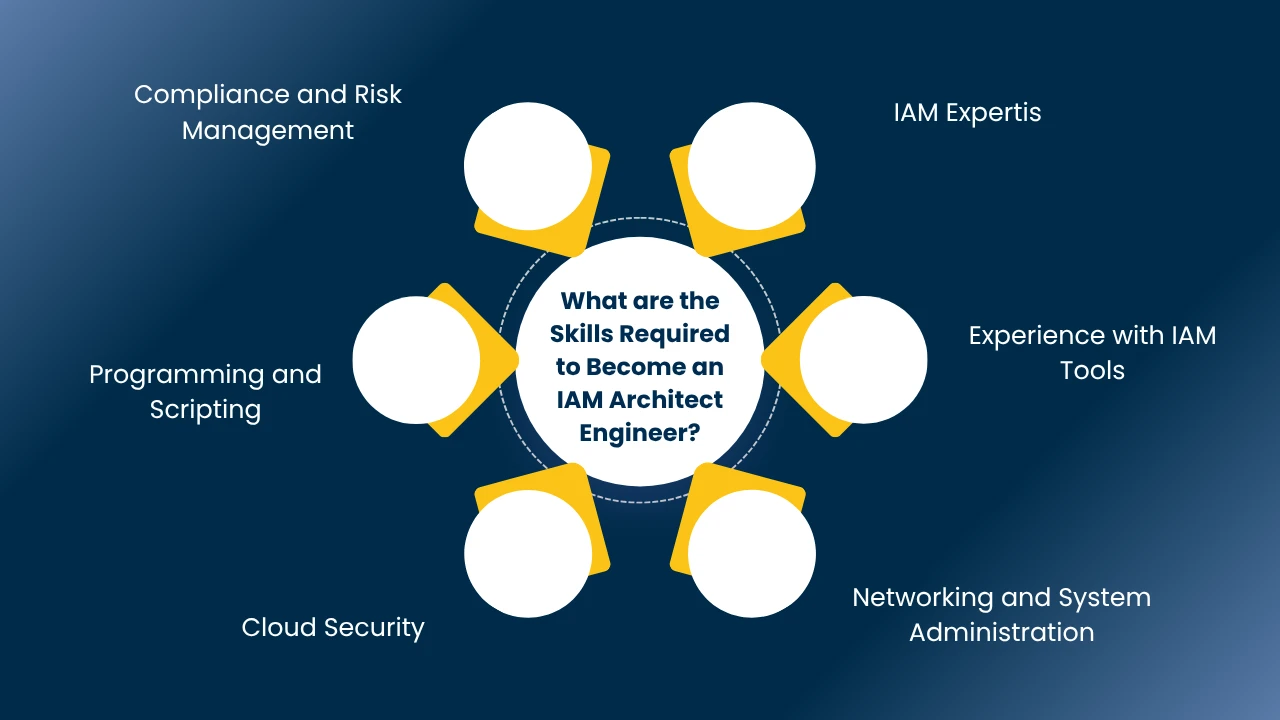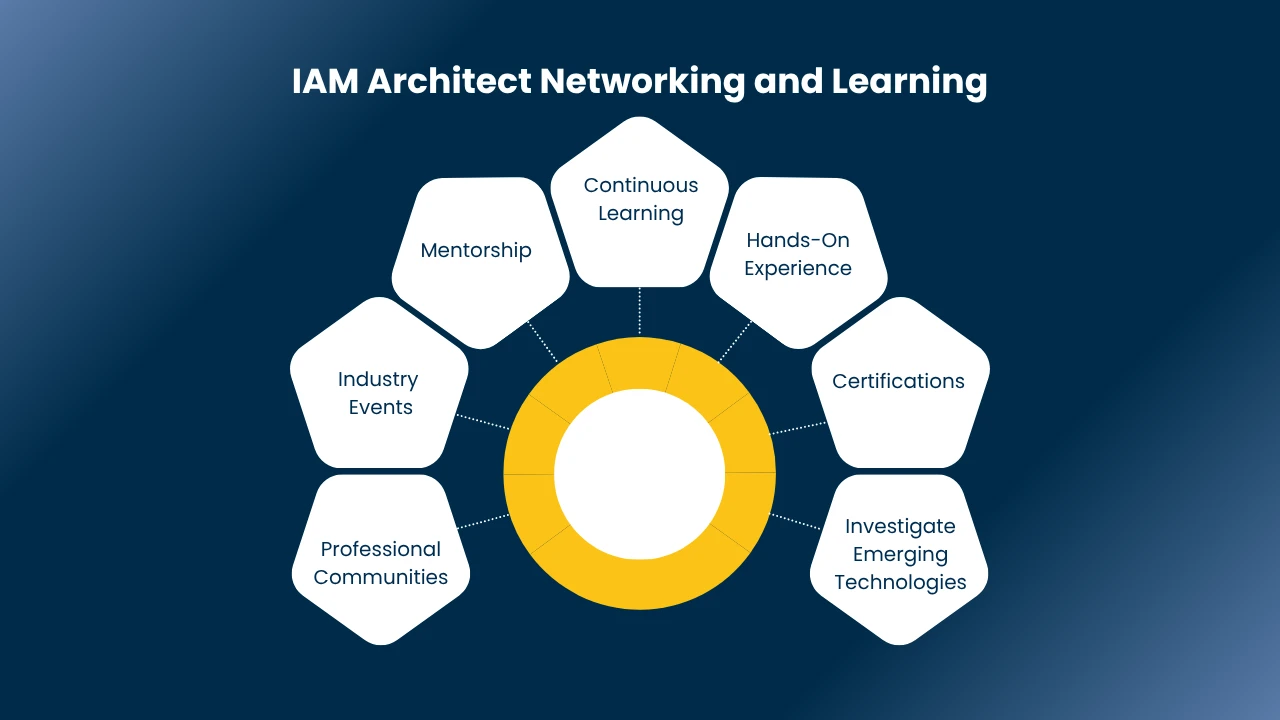An Identity and Access Management (IAM) Engineer is a key component of cybersecurity whose job is to determine who should have access to an organization’s systems, applications, and data. IAM Engineers design and operate security systems which allow access only by approved users, preventing sensitive information from being accessed by unauthorized individuals.
IAM Engineers implement access control policies and mechanisms. It includes multi-factor authentication, single sign-on, and biometric authentication. Additionally, they work with IT, security staff, and developers to implement these solutions into existing systems.
Their role covers the whole user life cycle from setting up new user accounts right through to changing permissions and providing access. They also check security logs to detect any possible security vulnerabilities, avoiding data breaches and ensuring industry compliance. If you are planning to pursue a career as IAM Engineer, you should be aware of skills and responsibilities involved.
In this blog, we are going to guide you through the process of how to become an IAM Engineer, starting from certifications and career guidance with special emphasis on how Cybersec Training can guide you to start the same.
Top 10 Required Skills to Become an IAM Engineer
IAM Engineers need a well-rounded set of skills that combine technical expertise, security consciousness, and interpersonal skills. Because these IAM engineer skills enable them to design, deploy, and administer effective identity and access management systems securely. Here are the key skills that each IAM Engineer should learn in order to excel in this role.
1. Security Knowledge
You must be aware of the access control models like RBAC, discretionary and mandatory access. Additionally, you must know the authentication methods like multi-factor authentication and single sign-on.
2. Technical Competency
To automate IAM processes and integrate solutions. You must be proficient in programming and scripting languages like Python and PowerShell.
3. Directory Services
One should have the knowledge of directory services like Active Directory and LDAP, including directory integration.
4. Federated Identity Protocols
You must have a knowledge of protocols like SAML, OAuth, and OpenID Connect to enable secure identity federation.
5. Networking and Security Protocols
You must understand networking concepts and security protocols like SSL/TLS to protect communications.
6. Risk Management and Compliance
Skills to assess security threats and upkeep regulations like GDPR, HIPAA, and PCI DSS.
7. Problem Solving and Troubleshooting
Skills to spot and resolve IAM system intricacies and access management problems.
8. Communication and Collaboration
Strong communication skills to work collaboratively with cross-functional teams and stakeholders.
9. Documentation and Project Management
Skills in crafting efficient IAM policies and managing IAM project schedules.
10. Continuous Learning and Certifications
Being updated on industry trends and earning credentials such as CIAM or CIMP to increase expertise.
Also Read: SailPoint IdentityIQ Training in Jaipur: Fees, and Training Duration.
What is the Typical IAM Engineer Job Description?
An IAM Engineer plays a vital part in securing an organization’s systems and data by developing and maintaining identity and access management solutions. An IAM Engineer must possess technical skills, security knowledge, and collaboration to develop robust IAM frameworks that identify unauthorized entry and ensure regulatory compliance. Below is a typical job description with the responsibilities and requirements anticipated.
IAM Engineer Job Responsibilities
- Implement, design, and maintain IAM solutions like access controls, authentication, and user provisioning.
- Collaborate with business units to synchronize IAM policies with the organizational needs.
- Conduct risk analyses and develop security controls for the protection of sensitive data.
- Scan access logs and security incidents for monitoring and responding to threats.
- Ensure compliance with industry regulations and best practices.
- Deploy IAM processes using scripting and programming languages.
- Support IAM-related projects with IT team coordination.
- Stay abreast of new IAM technologies and security trends.
IAM Engineer Job Requirements
- Bachelor’s degree in computer science, IT, or relevant field.
- Experience in designing, implementing, and maintaining IAM systems.
- High access control model and authentication protocol expertise.
- Proficiency in scripting languages such as Python or PowerShell.
- Knowledge of IAM tools such as Microsoft Identity Manager, Okta, or Ping Identity.
- Knowledge of federated identity protocols: SAML, OAuth, OpenID Connect.
- Preferred relevant certifications such as CIAM and CIMP.
- Effective communication and team working skills.
- Analytical and methodical approach to problem-solving and faultfinding.
How to Become an IAM Engineer?
To be an IAM Engineer, you must have formal education, on-the-job training, certificates, and lifelong learning. By taking a systematic path, you can gain the skills and competencies needed to succeed in this fast-moving and crucial cybersecurity role.
1. Educational Background
Start a bachelor’s degree in computer science, information technology, or a field related to it. This provides the fundamental knowledge required for systems, networks, and security knowledge. Besides, some professionals also obtain advanced degrees for added expertise.
2. Technical Skills
Develop strong technical expertise via the learning of programming languages such as Python or PowerShell which are used for automation. Gain hands-on experience in directory services like Active Directory and expertise about critical networking protocols and security measures. Familiarity with specific IAM products will also be useful.
3. Obtain IAM Certifications
Pursuing certifications such as Certified Identity and Access Manager (CIAM), Certified Identity Management Professional (CIMP), or Certified Access Management Specialist (CAMS) can validate your proficiency and promote professional standing in IAM.
4. Gain Practical Experience
Seek internships or entry-level positions in IT, cybersecurity, or system administration to gain hands-on experience. Seek assignments with access control, authentication, and user provisioning tasks to gain increasingly specialized knowledge in IAM.
5. Specialize and Remain Current
As you progress, specialize in job areas like identity federation, privileged access management (PAM), or cloud identity services. Maintain your skills current on IAM technologies and cybersecurity trends so that you remain competitive at all times.
6. Network with Experts
Join the IAM community by attending conferences, professional groups, and online communities. Networking can lead to mentorship and opportunities for professional advancement.
7. Cultivate Soft Skills
Include technical skills with soft skills such as communication, problem-solving, and adaptability. IAM Engineers often move between teams, so collaboration is essential.
8. Advanced Degrees (Optional)
If you see yourself in leadership or research roles, higher degrees such as a master’s or PhD can include greater understanding of complex security concerns and advance you to senior positions.
Also Read: What is IAM Engineer Salary in India in Different Countries in 2025
How To Transition To an IAM Engineer Job?
Transitioning into an IAM Engineer role from related IT or security roles requires you to have a skill development strategy in place that leverages your existing skills and develops new IAM-related skills. Below are steps to help you transition into this career change successfully.
1. Assess Your Current Skills: Walk through your current skill set and identify transferable experience in system administration, network security, access controls, and user provisioning. Having these will qualify you for IAM roles.
2. Acquire IAM Knowledge: Make an investment to learn IAM fundamentals through self-study, formal schooling, online courses, and certifications. Study best practices and related technologies used in the IAM space.
Benefit from Your Current Role
Try to do IAM-related activities in your present role. Provide your services for access management projects or collaborate with security teams to gain hands-on exposure.
1. Seek Mentorship
Talk to IAM experts for guidance and advice. Mentors can give you information about the industry and steer you towards your career transition.
2, Get Applicable Certifications
Obtain vendor-agnostic certifications like those of Identity Management Institute, as well as those of leading IAM products, to become more job-ready.
3. Build a Project Portfolio
Showcase your IAM hands-on experience by submitting a portfolio of projects, e.g., implementations or process improvements that you implemented, to demonstrate your hands-on skills.
4. Enhance Your Resume
Tailor your resume to reflect IAM-related experiences and skills, including IAM job listing keywords to align with employer needs.
5. Pursue Entry-Level IAM Jobs
Look for entry-level IAM engineer jobs, declaring your devotion to the career and readiness to learn in resumes and job interviews.
6. Educate Yourself and Network
Educate yourself on IAM industry trends, participate in webinars, and connect with professional networks to build connections and secure work.
7. Be Patient and Persistent
Career transitions require time. Continue developing your skills, searching for opportunities, and being proactive to enhance your success rate.
IAM Engineer Certification
Certifications play a significant role in confirming your proficiency and credibility as an IAM Engineer. The Identity Management Institute (IMI) offers a variety of industry-standard certifications that focus on different domains of identity and access management. The certifications allow professionals to delve deeper into the subject matter and aim for better opportunities in the IAM profession.
1. Certified Identity and Access Manager (CIAM)
The CIAM® is a professional certification for individuals responsible for identity and access programs. It covers core areas including policy development, plan for implementation, and IAM governance models.
2. Certified Access Management Specialist (CAMS)
CAMS® handles access management specifics like access control models, authentication techniques, and authorization methods, providing skills to experts for efficient protection of user access.
3. Certified Identity Management Professional (CIMP)
CIMP® is tailored to technical professionals who design, develop, and implement IAM systems. It is centered on architecture best practices, standards, and team collaboration to safely manage digital identities in organizations.
Read More: SailPoint IdentityIQ vs IdentityNow: Which is Right for You?
How Do I Start A Career In Identity And Access Management with Cybersec Trainings?
IAM career can be lucrative and rewarding with proper training and mentoring. Cybersec Trainings offers comprehensive IAM courses that will equip you with practical skills and theoretical knowledge to succeed in this career. Their course offers basic IAM concepts, lab exercises, and real-world scenarios to prepare you for addressing the job challenges.
With Cybersec Trainings, you are given industry-expert trainers, updated course materials, and certification guidance as per the requirements of the industry. Whether one intends to embark on a career in cybersecurity or focus on specializing in it, their training programs help in developing a solid foundation of IAM technologies, protocols, and best practices.
Additionally, Cybersec Trainings assists you in career growth with resume preparation, interview practice, and professional networking. When you take their IAM training, you become one step closer to becoming an IAM Engineer, capable of protecting digital identities and securing organizational assets effectively.
Conclusion
A profession as an Identity and Access Management (IAM) Engineer is a lucrative one, bridging technical know-how with critical security responsibilities. As the increased importance of protecting digital identities gains momentum, qualified IAM experts are highly sought after across industries. By gaining key skills, earning relevant certifications, and leveraging experiential learning, you can successfully join and become a leading figure in this challenging career.
Cybersec Trainings gives you the perfect foundation for starting with personalized IAM courses, hands-on training, and mentorship to provide you with a rock-solid foundation. Ongoing learning, networking, and staying current with industry trends will be the foundation for propelling your IAM Engineer career path. Step up to the challenge, invest in yourself, and you’ll be ready to contribute meaningfully to securing digital assets in today’s evolving cybersecurity landscape.










